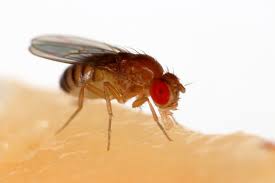 Drosophila melanogaster is a species of fly of the taxonomic order Diptera in the family Drosophilidae.
Drosophila melanogaster is a species of fly of the taxonomic order Diptera in the family Drosophilidae.
It is often referred to as the fruit fly, though its common name is the vinegar fly.
D. melanogaster is widely used in research owing to its rapid life cycle, relatively simple genetics with only four pairs of chromosomes, and large number of offspring per generation.
Its geographic range includes all continents, and islands.
D. melanogaster is a common pest in homes, restaurants, and other places where food is served.
Wild type fruit flies are yellow-brown, with brick-red eyes and transverse black rings across the abdomen.
The red color of the eyes of the fly are due to two pigments: xanthommatin, and drosopterins.
Flies exhibit sexual dimorphism.
Females are about 2.5 mm long.
Male flies are slightly smaller than females, with darker backs.
Males have a distinct black patch at the abdomen, and a row of dark bristles on the tarsus of the first leg.
Male fruit flies have spiked hairs surrounding the reproducing parts used to attach to the female during mating.
These hairs can sense air currents with the hairs on their backs.
D. melanogaster eyes are sensitive to light intensity and will allows them to fly away when a shadow or other movement is detected.
The D. melanogaster lifespan is about 50 days from egg to death.
The developmental period for D. melanogaster varies with temperature.
Under crowded conditions, development time increases, and the emerging flies are smaller.
Female fruit flies lay some 400 eggs, about five at a time, into rotting fruit or other suitable material such as decaying mushrooms.
Drosophila melanogaster undergoes a full metamorphosis.
Their life cycle is broken down into 4 stages: embryo, larva, pupa, adult.
The eggs, which are about 0.5 mm long, hatch after 12–15 hours (at 25 °).
The resulting larvae grow for about 4 days while molting twice at about 24 and 48 h after hatching.
Larvae feed on the microorganisms that decompose the fruit, as well as on the sugar of the fruit itself.
The mother fruit fly puts feces on the egg sacs to establish the same microbial composition in the larvae’s guts.
The larvae encapsulate in the puparium and undergo a 4-day-long metamorphosis, after which the adults emerge.
Males perform a sequence of five behavioral patterns to court females: playing a courtship song by horizontally extending and vibrating their wings, positions himself at the rear of the female’s abdomen to tap and lick the female genitalia, and finally attempts copulation.
Copulation lasts around 15–20 minutes, during which males transfer a few hundred, sperm cells in seminal fluid to the female.
Females store the sperm from multiple matings that compete for fertilization.
The last male to mate with a female sires about 80% of her offspring.
D. melanogaster is often used for life extension studies, such as to identify genes purported to increase lifespan.
when mutated.
D. melanogaster had been used in laboratories to study genetics and patterns of inheritance.
Ethanol produced by decaying fruit is a natural food source and location for Drosophila at low concentrations.
At high concentrations of ethanol, it can induce oxidative stress and alcohol intoxication.
Drosophila’s fitness is increased by consuming low concentrations of ethanol.
Initial exposure to ethanol causes hyperactivity, followed by incoordination and sedation
Comparing the fruit fly and the human genome, it is estimated that about 60% of genes are conserved between the two species.
About 75% of known human disease genes have a recognizable match in the genome of fruit flies.
About 50% of fly protein sequences have mammalian homologs.
Drosophila is being used as a genetic model for neurodegenerative disorders Parkinson’s, Huntington’s, spinocerebellar ataxia and Alzheimer’s disease, the study of aging and oxidative stress, immunity, diabetes, and cancer, as well as drug abuse.
Drosophila has detailed neural circuits.
Its life cycle of this insect has four stages: fertilized egg, larva, pupa, and adult.
Sucrose stimulates gustatory receptor neurons, which is necessary to stimulate aggression.
The compound eye of the fruit fly contains 760 unit eyes, and are one of the most advanced among insects.
Each unit (ommatidium) contains eight photoreceptor cells (R1-8), support cells, pigment cells, and a cornea.
The fruit fly is not blinded by ambient light.
About two-thirds of the Drosophila brain is dedicated to visual processing.
The fruit fly spatial resolution of vision is significantly worse than that of humans.
The fruit fly temporal resolution is around 10 times better than humans.
Drosophila exhibit predictable grooming behaviors.
Drosophila typically walk using a tripod gait.
Flies fly via straight sequences of movement interspersed by rapid turns called saccades.
During saccades, a fly is able to rotate 90° in less than 50 milliseconds.
Drosophila do not transmit human disease and are essentially harmless: they do not fulfill the criteria to be classified as a vector.
D. melanogaster is attracted to fruit that is already rotting, rather than causing fruit to rot.
